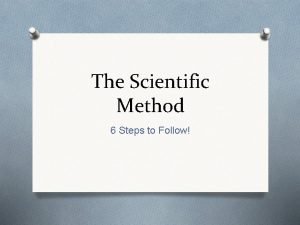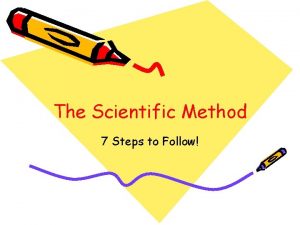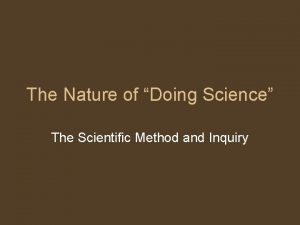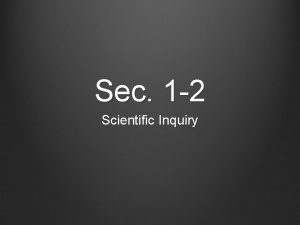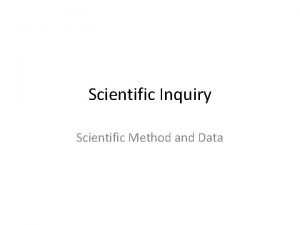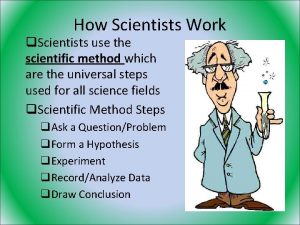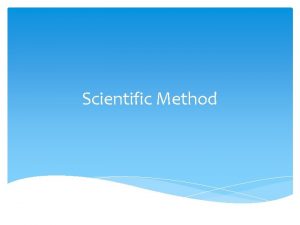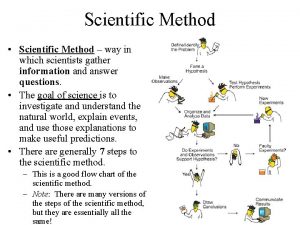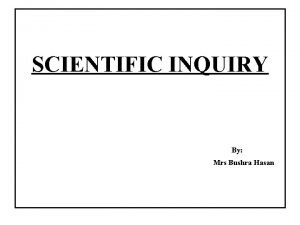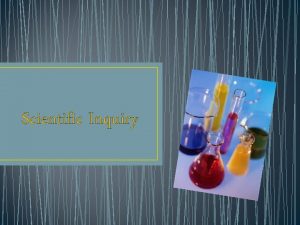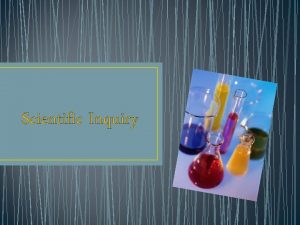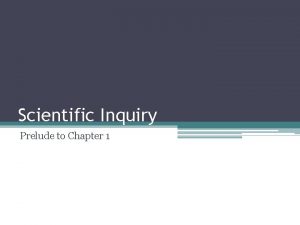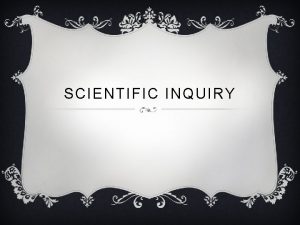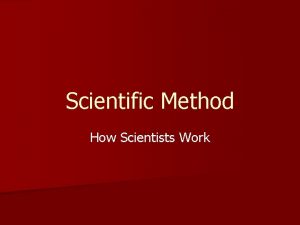Scientific Inquiry the way scientists work Scientific Inquiry
















- Slides: 16

Scientific Inquiry the way scientists work

Scientific Inquiry involves: • Questioning • Observing (using senses to gather information) • Inferring (conclusions based on observations) • Experimenting • Collecting and organizing data • Finding evidence and drawing conclusions • Repeating the experiment several times • Peer review

Questioning is at the basis of science. Scientists wonder how the world works and take the time to develop questions that can be tested answered.

Observations are things or events that are made using any of the senses or tools, such as thermometers, rulers, balances, graduated cylinders, microscopes

Inferences are attempts to explain or interpret observations Example – You observed a bird feeding at a bird feeder. You might infer that the bird’s nest is near by. But, the bird may be just passing through. You will need to investigate further.

Rules for experiments 1. Experiment should be done on a large number of people (large sample size). 2. The experiment should be repeated many times and give the same results. 3. The experiment should have a control. The control group should be identical to the experimental group except it will not get the material or treatment being tested. 4. Analyze the information to make sure the results are valid and show a significant trend.

Research Plans involve: • finding background information (using scientific journals, internet, books, etc. • developing a hypothesis (educated guess about what will happen in the experiment • devising an experimental process for testing a hypothesis using a large sample size and a control group

Independent Variable – variable in the experiment that is being tested; it is the part of the experiment that we change Dependent Variable – variable in the experiment that is being measured; it is the responding variable Control – reference point that is used as a standard for comparison ONLY ONE VARIABLE SHOULD BE TESTED IN AN EXPERIMENT!!

Designing an Experiment Purpose – The purpose of this experiment is to determine the effect of gibberellic acid on plant growth. Hypothesis

Designing an Experiment Purpose – The purpose of this experiment is to determine the effect of gibberellic acid on plant growth. Hypothesis - If plants are treated with gibberellic acid, then they will grow taller.

Procedure (What we will do) 1. Take a large number of plants of the same type (bean plants). Divide them into two groups, one group will be given gibberellic acid (experimental group) and the other will not (control group). 2. Both groups will be kept under the same conditions – same pot size, same amount of soil, same amount of water, vitamins and light. 3. Observe and measure the height of the plants at midday for five days. 4. Record the average height of the plants in each group for the five days.

Data Table Average Height of Plants (cm) Day 1 Day 2 Day 3 Day 4 Day 5 No acid___________________ With acid Independent variable ? Dependent variable?

Data Table No acid With acid Average Height of Plants (cm) Day 1 Day 2 Day 3 Day 4 Day 5 5 6 6. 5 7 7. 5 5 7 10 13 15 Graph the data to determine a trend. • The dependent variable is plotted on the vertical axis (y). • The independent variable is plotted on the horizontal axis (x). • The spacing between the numbers on both axes must be in equal increments.

16 14 12 10 Avg. Plant Height (cm) no acid 8 with acid 6 4 2 0 0 1 2 3 Days 4 5 6

Conclusion – The purpose of this experiment was to determine the effect of gibberellic acid on bean plants. The hypothesis that if plants are given gibberellic acid then they will grow taller is accepted. After 5 days, the average height of the plants in the group with no acid was 7. 5 cm and the average height of the plants in the experimental group was 15 cm. The plants treated with gibberellic acid grew to be twice as tall as the control plants.

Valid experiments • Conclusion is based on the observations • Experiment should have a control • Only one variable is being tested and everything else in the experiment is the same • There should be a large sample size • The experiment should be repeated many times and give the same results • The result should predict for new situations
 Scientific inquiry vs scientific method
Scientific inquiry vs scientific method How scientists work
How scientists work What are the 6 steps of the scientific method
What are the 6 steps of the scientific method Scientific method 7 steps
Scientific method 7 steps What is scientific inquiry
What is scientific inquiry Nature of scientific inquiry
Nature of scientific inquiry What does gg mean
What does gg mean Key club meaning
Key club meaning Perbedaan one way dan two way anova
Perbedaan one way dan two way anova Explain threaded binary tree
Explain threaded binary tree Perbedaan one way anova dan two way anova
Perbedaan one way anova dan two way anova 2 way anova example
2 way anova example One way anova vs two way anova
One way anova vs two way anova Pertanyaan tentang anova
Pertanyaan tentang anova Principles of conventional software engineering
Principles of conventional software engineering A bottle of rum to fill my tum
A bottle of rum to fill my tum Walk this way talk this way
Walk this way talk this way


